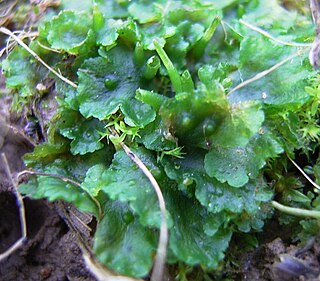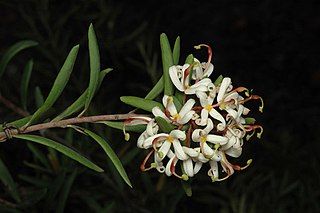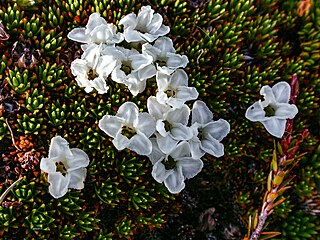
The Marchantiophyta are a division of non-vascular land plants commonly referred to as hepatics or liverworts. Like mosses and hornworts, they have a gametophyte-dominant life cycle, in which cells of the plant carry only a single set of genetic information.

The zebra mussel is a small freshwater mussel. The species originates from the lakes of southern Russia and Ukraine, but has been accidentally introduced to numerous other areas and has become an invasive species in many countries worldwide. Since the 1980s, the species has invaded the Great Lakes, Hudson River, and Lake Travis.

Acacia koa, commonly known as koa, is a species of flowering tree in the family Fabaceae. It is endemic to the Hawaiian Islands, where it is the second most common tree. The highest populations are on Hawaiʻi, Maui and Oʻahu.

Lomatia tasmanica, commonly known as King's lomatia, is a shrub of the family Proteaceae native to Tasmania. Growing up to 8 metres (26 ft) tall, the plant has shiny green pinnate (lobed) leaves and bears red flowers in the summer, but yields neither fruit nor seeds. King's lomatia is unusual because all of the remaining plants are genetically identical clones. Because it has three sets of chromosomes and is therefore sterile, reproduction occurs only vegetatively: when a branch falls, that branch grows new roots, establishing a new plant that is genetically identical to its parent.

Dreissena is a genus of small freshwater mussels in the family Dreissenidae in the class Bivalvia. They are found attached to firm substrates by threads from underneath the shells and are the only freshwater bivalves to attach to hard substrates in high densities while having a planktonic larval stage. They are considered the most aggressive freshwater invader in the world because of their ability to invade environments in every one of their life cycle.

The Hawaiian tropical rainforests are a tropical moist broadleaf forest ecoregion in the Hawaiian Islands. They cover an area of 6,700 km2 (2,600 sq mi) in the windward lowlands and montane regions of the islands. Coastal mesic forests are found at elevations from sea level to 300 m (980 ft). Mixed mesic forests occur at elevations of 750 to 1,250 m, while wet forests are found from 1,250 to 1,700 m. Moist bogs and shrublands exist on montane plateaus and depressions. For the 28 million years of existence of the Hawaiian Islands, they have been isolated from the rest of the world by vast stretches of the Pacific Ocean, and this isolation has resulted in the evolution of an incredible diversity of endemic species, including fungi, mosses, snails, birds, and other wildlife. In the lush, moist forests high in the mountains, trees are draped with vines, orchids, ferns, and mosses. This ecoregion includes one of the world's wettest places, the slopes of Mount Waiʻaleʻale, which average 373 in (9,500 mm) of rainfall per year.
Bolster heath or cushion moorland is a type of vegetation community that features a patchwork of very low growing, tightly packed plants found at the limits of some alpine environments. The cushion plants form a smooth surfaced 'cushions' from several different plants, hence the common name of cushion heath. The cushion growth habit provides protection against the desiccating wind and help keep the cluster warm.

Metrosideros polymorpha, the ʻōhiʻa lehua, is a species of flowering evergreen tree in the myrtle family, Myrtaceae, that is endemic to the six largest islands of Hawaiʻi. It is a member of the diverse Metrosideros genus, which are widespread over the southwest Pacific.

Medicago polymorpha is a plant species of the genus Medicago. It is native to the Mediterranean basin but is found throughout the world. It forms a symbiotic relationship with the bacterium Sinorhizobium medicae, which is capable of nitrogen fixation. Common names include California burclover, toothed bur clover, toothed medick and burr medic.

Marchantia polymorpha is a species of large thalloid liverwort in the class Marchantiopsida. M. polymorpha is highly variable in appearance and contains several subspecies. This species is dioicous, having separate male and female plants. M. polymorpha has a wide distribution and is found worldwide. Common names include common liverwort or umbrella liverwort.

Quercus polymorpha, the Mexican white oak, Monterrey oak or netleaf white oak, is a North American species of oak. It is widespread in Mexico, Guatemala, and Honduras, and known from a single population in the United States but widely planted as an ornamental.

Mitrasacme is a genus of plants in the family Loganiaceae. Around 40 species occur, mostly in Australia, though also extending to various parts of Asia and the Pacific Islands. Two species also occur in China.

Phaeoceros laevis, the smooth hornwort, is a species of hornwort of the genus Phaeoceros. It is commonly found in areas where moisture is plentiful, such as moist soils in fields, the banks of streams and rivers or inundated beneath the surface of the rivers. It grows to a maximum height of about 5 millimetres and the plants are monoecious; the sex organs are visible on the dorsal surface.

Marchantia berteroana is a liverwort species in the genus Marchantia.
Arotrophora euides is a species of moth of the family Tortricidae. It is found in Australia, where it has been recorded from Tasmania. The habitat consists of subalpine open woodland at altitudes between 860 and 950 meters.

Lomatia tinctoria, commonly known as guitar plant, is a shrub to about 2 metres tall of the family Proteaceae. It is one of three species of Lomatia endemic to Tasmania, the others being L. polymorpha and L. tasmanica. Lomatia tinctoria is closely related to L. polymorpha, with which it sometimes hybridises. Its leaves are divided, while those of L. polymorpha are simple.

Lomatia polymorpha, commonly known as mountain guitar plant, is a shrub or small tree of the family Proteaceae which is endemic to Tasmania. It is a shrub or small tree with linear leaves, and white, cream-coloured or greenish flowers. It is common throughout its range which is approximately complementary to that of L. tinctoria in Tasmania.
Synaphea polymorpha, commonly known as Albany synaphea, is a species of small shrub in the flowering plant family Proteaceae. It is endemic to Western Australia. The Noongar peoples know the plant as bindak.

Dracophyllum minimum, commonly known as heath cushionplant or claspleaf heath, is a species of bolster cushion plant endemic to Tasmania, Australia. It is a low growing, highly compacted plant with white flowers, commonly found in alpine areas of the south, centre and west of Tasmania.
Carex californica is a tussock-forming species of perennial sedge in the family Cyperaceae. It is native to western parts of the United States.
















